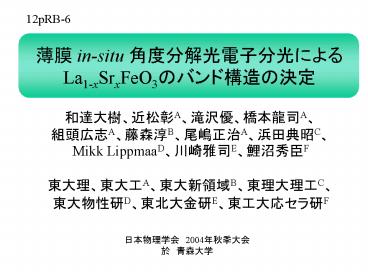insitu La1xSrxFeO3 - PowerPoint PPT Presentation
1 / 15
Title:
insitu La1xSrxFeO3
Description:
?? in-situ ????????????. La1-xSrxFeO3?????????. ????????A????????? ... Tsub = 950 oC, PO2 = 1.0 10-4 Torr. then post-annealed in oxygen atmosphere. Measurements ... – PowerPoint PPT presentation
Number of Views:63
Avg rating:3.0/5.0
Title: insitu La1xSrxFeO3
1
?? in-situ ????????????La1-xSrxFeO3?????????
12pRB-6
- ????????A?????????A?
- ????A????B?????A?????C?
- Mikk LippmaaD?????E?????F
- ???????A??????B??????C?
- ?????D??????E????????F
?????? 2004????? ? ????
2
Physical properties of La1-xSrxFeO3
Crystal structure of La1-xSrxFeO3
TN 300 K
three-dimensional perovskite structure (no
cleavage plane)
charge disproportionation
J. Matsuno et al., PRB 60, 4605 (1999).
- Wide insulating region.
- Charge disproportionation at x0.67.
3
Composition dependence (XPS XAS spectra)
H. Wadati et al., cond-mat/0404435, PRB in
press.
- Structures A-C move toward EF with increasing x
(hole-doping). - Structure A becomes weaker with increasing x.
- ? Holes are doped into eg state.
- Spectral weight is transferred from eg band to
the states above EF (structure F). ?
non-rigid-band behavior
4
Principles of angle-resolved photoemission
spectroscopy
Emission of an electron from a solid to vacuum
La1-xSrxFeO3 (x 0.4) thin film in-plane a
3.905Å out-of-plane c 3.883 Å
q polar emission angle
a c
m free electron mass hn energy of an
absorbed photon f work function of the
sample EB binding energy V0 inner potential
5
Samples
Tsub 950 oC, PO2 1.010-4 Torr then
post-annealed in oxygen atmosphere
growth conditions
Measurements
- Photon Factory (PF) BL-1C
- SCIENTA SES-100 analyzer
- hn 60, 68, 88 eV
- DE 150 meV
- T 150 K (lt TN 300 K)
6
In-situ Laser MBE photoemission Combined System
LEED patterns
87 eV
Sharp 11 spots
AFM image (ex-situ)
K. Horiba et al., RSI 74 3406 (2003)
Atomically flat step-and-terrace structures
7
Trace in k-space
EB 2 eV, f 4.5 eV, V0 10.5 eV, a 3.905 Å,
c 3.883 Å
Brillouin zone
kz
R
M
kz
M
X
kx
X
G
X
M
Black cubic Red GdFeO3-type distortion
(G-type AF)
shadow band
kx
G ? X
R ? M
X ? M
M ? X
8
ARPES spectra at 68 eV
Experimental band structure
ARPES spectra
eg bands (-1.3 eV) significant dispersion t2g
bands (-2.4 eV) weak dispersion O 2p bands (-4
-6 eV)
9
Band-structure calculation
1. Tight binding calculation (SrTiO3) (A. H.
Kahn and A. J. Leyendecker, Phys. Rev. 135, A1321
(1964).) cubic scaling of band width, shadow
band (band folding), estimation of EF from
band filling 2. LDAU band-structure
calculation (LaFeO3) (N. Hamada) Orthorhombic
(GdFeO3-type distortion) , G-type AF, U 2.0 eV
GdFeO3-type distortion
G-type AF
10
Comparison with band-structure calculation 1
Experimental eg band not crossing EF ? wide
insulating region Band folding Fe 3d bands
G-type AF and/or GdFeO3-type distortion O 2p
bands mainly GdFeO3-type distortion
Tight binding calculation (SrTiO3) A. H. Kahn
and A. J. Leyendecker, Phys. Rev. 135, A1321
(1964).
11
Dispersion of eg bands
60 eV
68 eV
- Bottom at X point. ( -1.4 eV)
- Band folding due to G-type AF and/or GdFeO3-type
distortion is observed. - ? insulating behavior
12
Comparison with band-structure calculation 2
majority
LDAU band-structure calculation (LaFeO3) N.
Hamada
- Band folding of Fe 3d eg band could be
reproduced. - Fe 3d t2g band was composed of so many bands.
- ? Weak dispersion is observed.
- Band width experiment calculation
13
Comparison with XPS and XAS results
H. Wadati et al., cond-mat/0404435, PRB in press.
- Band structure of LSFO (x 0.4) is in good
agreement with the LDA U band-structure
calculation of LFO (x 0). - With increasing x, eg band becomes weaker and
approaches EF , but does not cross EF . The gap
was seen for all values of x.
14
Summary
- We have performed in-situ ARPES measurements on a
single-crystal thin film of La1-xSrxFeO3 (x
0.4) and determined its band structure. - Several dispersive bands (Fe 3d eg bands, t2g
bands, O 2p bands) were observed. Band folding
due to G-type AF and/or GdFeO3-type distortion
was observed. We interpreted the results in two
different models.
1. Tight binding calculation
- The experimental band structure was interpreted
by scaling the bandwidth, superposing the shadow
bands, and shifting the EF position according to
band filling.
2. LDA U band-structure calculation
- The experimental band structure was interpreted
using LDA U band-structure calculation of
LaFeO3. - With hole doping, eg band becomes weaker and
approaches EF, but does not cross EF (consistent
with the XPS and XAS results).
15
Band-structure calculation (SrTiO3)
A. H. Kahn and A. J. Leyendecker, Phys. Rev. 135,
A1321 (1964).































